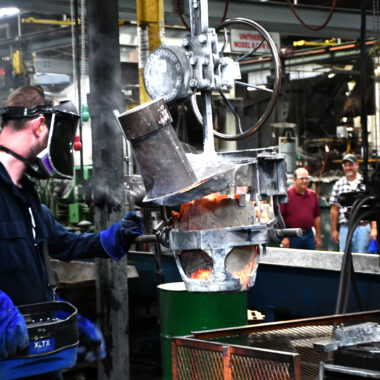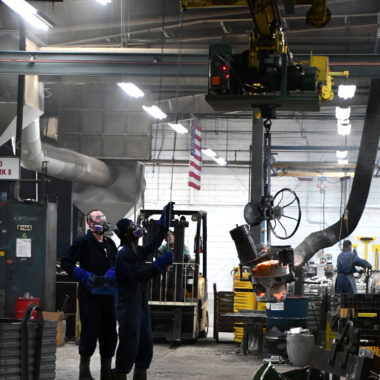Precision in Practice: The Art About Aluminum Casting
Wiki Article
Opening the Potential of Light Weight Aluminum Casting: Proven Techniques for Success
Light weight aluminum casting has actually long been identified for its flexibility and extensive applications throughout numerous industries. Join us as we discover the necessary elements that can thrust aluminum casting towards unmatched success in today's competitive market landscape.Advantages of Light Weight Aluminum Spreading
Light weight aluminum spreading offers a wide range of advantages that make it a favored selection in numerous commercial applications. One of the primary benefits of light weight aluminum spreading is its light-weight nature, which adds to sustain efficiency in industries such as automotive and aerospace. Furthermore, light weight aluminum is very flexible, permitting for intricate and complex shapes to be easily produced through casting procedures. This versatility in layout is a substantial advantage for sectors that require components with specific geometries.In addition, light weight aluminum spreading provides outstanding rust resistance, making it excellent for applications where exposure to extreme atmospheres is a problem. The material also displays excellent thermal conductivity, which is helpful for sectors calling for heat dissipation, such as electronics (about aluminum casting). Aluminum is completely recyclable, aligning with the expanding focus on lasting methods in contemporary production.
Design Factors To Consider for Casting
The design phase plays an important function in the general success of an aluminum spreading job. One essential consideration is the selection of suitable geometries and features that help with the spreading process.Additionally, factors to consider connected to parting lines, gating systems, and risers are necessary to stop defects like porosity and shrinkage. It is crucial to enhance the design for efficient material usage and minimize post-processing demands. Simulations and prototyping can be valuable devices in evaluating and improving the casting style before full-scale production.
Cooperation in between design manufacturers, designers, and shops is important to deal with any prospective obstacles early in the layout phase. By including these factors to consider into the spreading layout process, manufacturers can enhance item top quality, minimize prices, and ultimately open the full possibility of aluminum casting.
Enhancing Casting Efficiency
When aiming to enhance casting effectiveness in aluminum casting jobs,Designing with an emphasis on maximizing material flow and lessening problems is essential. To achieve this, making use of simulation software program can assist in recognizing possible issues before the spreading procedure starts. By simulating the circulation of molten aluminum, designers can adjust gating and riser designs to make sure proper dental filling and solidification, inevitably minimizing the event of flaws such as porosity or shrinking.
In addition, carrying out proper heat therapy processes can enhance the total casting effectiveness. Warm therapy can assist enhance the mechanical homes of the aluminum spreading, making sure that the last element satisfies the required specifications. Furthermore, utilizing automation and robotics in the spreading process can improve production, decrease hand-operated labor, and boost overall performance.
Moreover, constant tracking and quality assurance throughout the spreading procedure are crucial for recognizing any inconsistencies and making sure that the final products satisfy the preferred criteria. By executing these approaches, makers can boost casting performance, boost item quality, and inevitably accomplish better success in aluminum casting tasks.
Quality Assurance in Aluminum Spreading

Efficient quality control methods play a Learn More crucial role in guaranteeing the precision and reliability of aluminum casting processes. Quality control steps in aluminum casting incorporate a range of activities aimed at maintaining details criteria and determining variances that can endanger the last item.
In addition to process control, high quality control in aluminum casting includes rigorous screening and examination treatments at numerous phases of manufacturing. By executing robust quality control practices, aluminum spreading centers can provide products that meet customer assumptions for efficiency, integrity, and top quality.
Maximizing Earnings
To accomplish ideal economic efficiency, an extensive method for maximizing profitability within aluminum casting operations need to be meticulously created and carried out. One essential facet of taking full advantage of productivity in aluminum casting is optimizing manufacturing performance. This read more entails enhancing procedures, lowering waste, and minimizing downtime to make sure that sources are made use of efficiently. Carrying out lean production concepts can aid determine areas for renovation and improve total operational efficiency.
Furthermore, expanding product offerings and exploring brand-new markets can aid increase revenue streams. Recognizing client demands and market fads can direct critical decisions to profit from arising possibilities. Buying r & d to innovate procedures or products can also drive productivity via differentiation and client contentment.
Final Thought
To conclude, light weight aluminum casting offers various advantages in regards to design versatility, longevity, and cost-effectiveness. By thoroughly taking into consideration style considerations, boosting casting performance, implementing quality control actions, and maximizing productivity, makers can open the full possibility of aluminum casting. This dependable and flexible process has confirmed to be pop over to this web-site a successful choice for a variety of commercial applications.In addition, aluminum is highly malleable, allowing for complicated and intricate shapes to be easily produced through casting processes.Efficient top quality control techniques play an essential role in making certain the accuracy and dependability of light weight aluminum casting procedures.In addition to process control, quality control in light weight aluminum casting includes extensive testing and inspection treatments at various stages of manufacturing. By applying robust quality control techniques, aluminum casting facilities can supply products that meet client expectations for quality, performance, and integrity.
By thoroughly taking into consideration design factors to consider, boosting casting effectiveness, applying top quality control actions, and making the most of productivity, suppliers can unlock the full potential of light weight aluminum spreading.
Report this wiki page